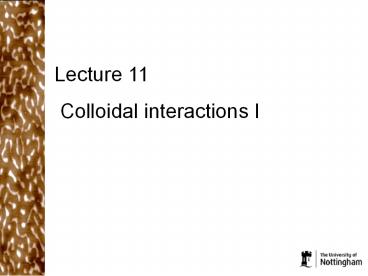Colloidal interactions I - PowerPoint PPT Presentation
Title: Colloidal interactions I
1
Lecture 11 Colloidal interactions I
2
In the last lecture
Capillary pressure due to a curved liquid
interface Capillary pressure is responsible for
phenomenon of capillary rise Capillary action
can be used to manufacture novel nanoscale
structures
h
3
In this lecture
1)What are Colloids and why are they important?
2) Colloidal stability 3) Interactions between
charged surfaces in solutions 4) Osmotic pressure
between two surfaces Further reading Intermolecul
ar and Surface Forces J. Israelachvili, Chapter
12 p213-259 Colloidal Dispersions suspensions,
emulsions and foams, I. D. Morrison and S. Ross,
Wiley p316-379
4
Colloids and nanoparticles
Continuous phase (e.g. water)
Colloids are mixtures where small particles (lt1
mm in diameter) of one substance are suspended in
a second medium or continous phase They are not
solutions! The material is not completely
dispersed, but exists as discrete particles
Colloidal particle
5
Why are colloids important?
Colloidal interactions govern the properties of
nanoscale systems in liquid environments
Ferrofluids
Quantum dots (CdSe)
Gold colloids
Food Science
Biomolecules
6
Key challenge in manufacturing colloidal
dispersions
When materials are dispersed in particulate form
they have a very large surface area. Their
natural tendency is to stick together or
flocculate to form an aggregate (more on
aggregation in a later lecture)
We have already seen that dispersion forces
result in a mutual attraction between particles
which can drive the flocculation of even very
dilute systems
7
How do we stop things sticking together?
We need to introduce a short range repulsion
force to keep particles apart. In water, this is
often done by decorating the surface of the
particles with charged groups and adding a small
amount of salt
add water add salt
But the reason why the particles repel is not
purely electrostatic
8
Charged surfaces in electrolytes
The added salt is often referred to as an
electrolyte In practice the electrolyte
concentration is much higher than the
concentration of ions due to dissociated
groups Some of the charged ions from the salt
form layers at the particle surfaces, ensuring
that charge neutrality is maintained
So if everything is charge neutral, how do the
particles repel one another?
9
Repulsive forces between charged surfaces in an
electrolyte
When two charged surfaces are brought close
together the counter-ion concentration between
the surfaces is larger than outside this region.
This results in an osmotic pressure, P, which
pushes the surfaces apart and tries to restore a
uniform concentration (see OHP)
Where n and n- are number densities of positive
and negative ions in gap
10
How do we calculate n and n-?
The number of counter ions of each charge is
determined by Boltzmann statistics
Where no is the number density in bulk solution
The energies of the charged counter ions with
valence z are given by
Where V(x) is the electrostatic potential at a
position x in the solution
11
Osmotic pressure between charged surfaces
Inserting the previous result into our expression
for the osmotic pressure gives (see OHP)
In the limit of small surface potentials this
reduces to
So if we know V(x) we can calculate the osmotic
pressure!
12
What form of V(x) should we use?
The true form of the electrical potential between
colloids is complicated. A good approximation to
V(x) is the form for the potential for an
isolated charged surface in an electrolyte. To
obtain this we must first solve the Poisson
equation
where r is the charge density (Cm-3) and eo is
the permittivity of free space
Note This equation is a differential form of
Gausss law! (see F31CO1 F32ON1 notes).
Derivation not examinable
13
Potential near a planar charged surface I
The total charge density in the gap between the
two surfaces is the sum of densities due to
positive and negative counterions If counterions
have a valence of z then assuming that n and
n- obey Boltzmann statistics, as before we
have (see OHP)
14
Potential near a planar charged surface II
Combining the above results gives a modified
version of the Poisson equation
In the limit of small potentials this reduces to
15
The Debye screening length
Assuming that the potential decays to zero for
infinite x, this equation has a solution which is
a simple exponential decay
Where 1/k is the Debye screening length
1/k is the distance over which electrostatic
interactions are screened in an electrolyte and
Vo is the potential at the surface
16
Problem 1
- Two surfaces are charged to a surface potential
of 10mV and are suspended in water (e80) which
also has a monovalent salt dissolved in it. - Calculate the Debye screening length between the
surfaces at room temperature if the salt
concentration is - 1mM
- 100mM
17
Osmotic pressure between surfaces (revisited)
Recall from a previous slide that the osmotic
pressure due to counterions has the form
If we insert our exponential form for the decay
of the potential this gives
where D2x is the separation between the surfaces
18
Total pressure between surfaces
The total pressure between two charged surfaces
in an electrolyte is
where Pdispersion is the pressure due to
attractive dispersion interactions
This is a simplified form of the Derjaguin,
Landau, Verwey, Overbeek (DLVO) theory of
colloidal stability
19
Pressure (Force) vs separation
Long range attractive dispersion forces
(negative) Short range double layer repulsion
forces (positive)
20
The effects of adding electrolyte
As more salt is added, electrostatic effects are
more strongly screened ? eventually attractive
dispersion forces dominate and surfaces will
stick together
21
Summary of key concepts
Colloidal stability is important in many areas of
nanotechnology It can be achieved by charging
surfaces
The pressure exerted on charged surfaces in an
electrolyte is determined by a balance between
the osmotic pressure due to counter-ions and the
dispersion pressure






























